Fire Alarm and Police Call Boxes
by Larry Pelland
Reprinted from "Crown Jewels of the Wire", April 1988, page 14
FIRE ALARM BOXES
In 1851, the city of Boston voted to award a contract to install a central
alarm office with 45 alarm boxes and the apparatus for striking signals on the
16 city bells. The following year, the new fire alarm telegraph system was
inaugurated.
In the first boxes, a notched code wheel was turned by a hand crank in front
of the box. This soon gave way to a spring driven clock work type mechanism to
drive the code wheel when actuated by a lever. If the lever was pulled more than
once, an incorrect signal would result.
As the systems expanded another problem arose. When two or more boxes on the
same circuit were pulled, they interfered with each other's signals, causing a
jumbled alarm. To better solve the problem, a successive box movement was
developed where the alarm from one box on a circuit would be allowed to finish
before another box on the circuit could send its signal.
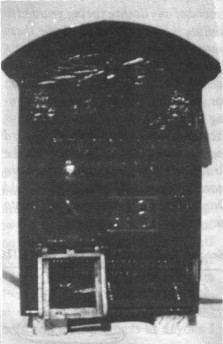
Early Gamewell Fire Alarm Box
circa 1900 with Cole Keyguard
The original hand-cranked boxes gave way to boxes locked with a key, which
was issued to Policemen, responsible citizens or kept on the side of the box. In
1900, the Gamewell Company's Cole Keyguard appeared with the instructions "break glass,
open door, pull handle down once, let go." In 1922 a quick action door was
made available, replacing the Cole Keyguard. Many of the fire alarm boxes in
service today are of this type.
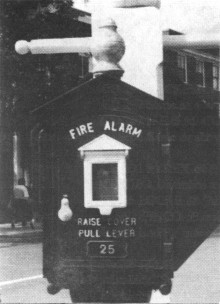
Fire alarm box made by Superior American Fire Alarm & Signal
Co. |
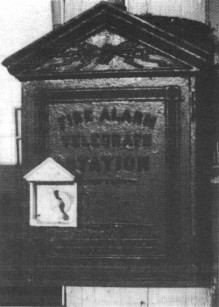
A Gamewell "cottage style"
fire alarm box made in New York |
After World War II, telephone alarm boxes began to appear with a direct phone
to fire headquarters inside. Fire alarm boxes are wired to an indicator which is an electro-magnetic device
hung on the wall in the firehouse. Revolving number wheels turn to indicate the
number of a fire alarm box when the alarm was activated.
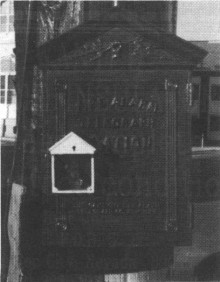
Another New York made Gamewell "cottage style."
Note the Game well
logo (clenched fist with lightning bolts)
compared to the logo in the fire
alarm box in the picture above.
There are a few varieties. One type just indicates the number of the box,
another includes a bell which rings out the number being displayed, while a
third just rings a notifier bell telling you to check the indicator for the box
number. In most cases, indicators were found in cities which had many alarm
boxes. They ranged in size up to 3 feet long with ornate wooden cases. On the
wall of the firehouse was placed a framed listing of box numbers and street
locations.
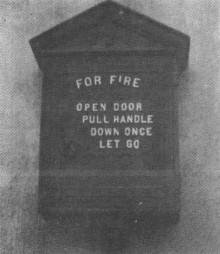
Gamewell Fire Alarm Box with missing Cole Keyguard |
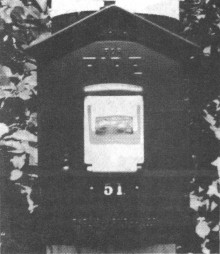
Gamewell Fire Alarm Box (new Style) made in Newton,
Massachusetts |
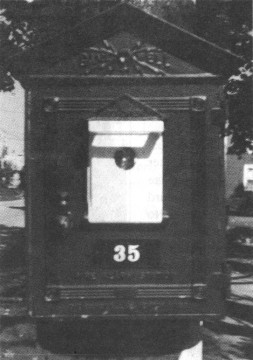
Gamewell Fire Alarm Box with quick action door. Made in Newton, Massachusetts |
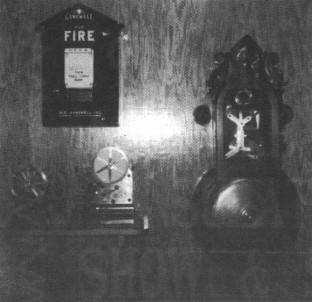
Gamewell Fire Alarm Box, Gamewell Indicator and Gamewell Fire Alarm register
at the Fire Station at Rutland, Vermont |
There were a number of manufacturers of the fire alarm boxes, but the
products of the Gamewell Company predominated. The Superior American Fire Alarm
& Signal Company manufactured fire alarm boxes that looked very much like
the ones made by Gamewell. Outside cases of alarm boxes were made of cast iron
until 1928. Thereafter they were made mostly of cast aluminum. Some of the early
Gamewell fire alarm boxes had the date of manufacture cast into the box above
the door.
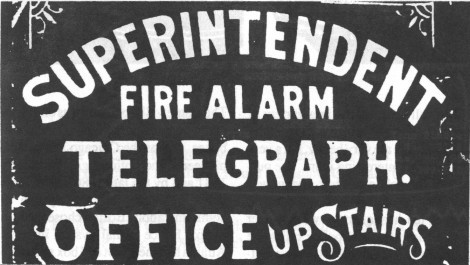
This 14" x 20" metal sign hung for many years in front of the
Paterson, New Jersey Fire Alarm Telegraph Office
Fire alarm boxes are fast disappearing all over the country. Many cities and towns are completely doing away with them
or switching over to radio transmitted boxes, eliminating the need to run wire
from the box to the alarm office.
POLICE CALL BOXES
Police call boxes come in a variety of sizes, shapes and weights. Generally
speaking they are very heavy, but a very unusual and interesting item. The
purpose of the police call box system was to allow the patrolman on the beat to
contact his headquarters with greater ease. These fine old police relics are
gradually being phased out in most metropolitan police forces and completely
replaced by radio.
The Gamewell Company was one of the early manufacturers of
police call boxes. It was the Chicago Police who pioneered the police signal
system in 1881 and by the late 1880's most large cities were adopting this
system of communication. Boston chose the Municipal Police Signal System in
1888. Atlanta had their first call box system in 1891.
One of the early Chicago boxes was a large heavy box with a peaked roof, made
of cast iron' and later in cast aluminum. On front of the peak it had a logo of
jagged streaks of lightning surrounding a star. The box was marked "Police
Patrol Station," had a number in the center and was further marked
"The Police Telephone and Signal Co.-- Chicago." Another large box
used by the Chicago Police was the same design but was marked "Police
Patrol Station -- Department of Electricity -- Chicago." The most popular
boxes used in Chicago were a somewhat smaller size (17" high, 10-3/4"
wide and 5-1/4" deep). It had the same peaked roof, either of cast iron or
aluminum, and was simply marked "Chicago Police" in raised lettering.
Some of the old boxes used in the east were of a different design, somewhat
rectangular with round corners and marked "Police Patrol Box" and the
name "Gamewell."
The Tucson Police Department also used the same design box with the Gamewell
name and logo, marked "Police Telegraph." Another style used by
various police departments was oval in shape and marked "Bell System."
They all are equipped with various styles of telephones. The lines from both
Police and Fire boxes shared space on utility poles with power and telephone
lines. The city of Fall River, Massachusetts, had insulators made on special
order for their police and fire telegraph systems. They are the CD 133 CITY FIRE
ALARM and the CD 134 FALL RIVER POLICE SIGNAL.
- - - - - - - - - - - - -
I am most grateful to the following resources for this article:
FIREHOUSE COLLECTIBLES, by Mary Jane and James Piatti. Published by Marvin H.
Cohen and The Engine House Publishing Company of Middletown, New York
POLICE RELICS, by George E. Virgines. Published by Collector Books, P.O. Box
3009, Paducah, Kentucky 42001
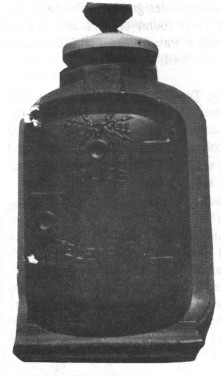
Police Call Box on a street corner in Schenectady,
New York |
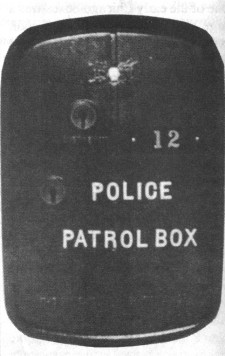
Gamewell Police Call Box |
| 